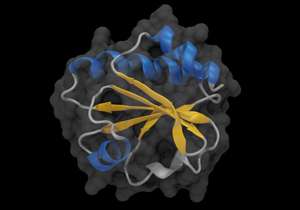Researchers resurrect ancient enzymes to reveal conditions of early life on Earth

(PhysOrg.com) -- Scientists from Columbia University, Georgia Institute of Technology and the University of Granada have for the first time reconstructed active enzymes from four-billion-year-old extinct organisms. By measuring the properties of these enzymes, they can examine the conditions in which the extinct organisms lived. The results shed new light on how life has adapted to changes in the environment from ancient to modern Earth.
In their study, published in the April issue of Nature Structural & Molecular Biology, the researchers used vast amounts of genetic data to computationally reconstruct the genes of extinct species, a technique known as ancestral sequence reconstruction. The researchers then went a step further and synthesized the proteins encoded by these genes. They focused on a specific protein, thioredoxin, a vital enzyme found in all living cells.
Julio Fernandez, professor in the Department of Biological Sciences, and his team conducted a detailed biophysical analysis of the reconstructed thioredoxin enzymes, using an atomic force microscope with single-molecule resolution.
“Given the ancient origin of the reconstructed thioredoxin enzymes, with some of them predating the buildup of atmospheric oxygen, we expected their catalytic chemistry to be simple,” said Fernandez. “Instead we found that enzymes that existed in the Precambrian era up to four billion years ago possessed many of the same chemical mechanisms observed in their modern-day relatives.”
Further examination of the ancient enzymes revealed some striking features: The enzymes were highly resistant to temperature and were active in more acidic conditions. The findings suggest that the species hosting these ancient enzymes thrived in very hot environments that since then have progressively cooled down, and that they lived in oceans that were more acidic than today.
“By resurrecting proteins, we are able to gather valuable information about the adaptation of extinct forms of life to environmental alterations that cannot be uncovered through fossil record examinations,” said Eric Gaucher, an expert in ancestral sequence reconstruction at the Georgia Institute of Technology.
The researchers are now looking to apply their strategy to other enzymes to get a clearer picture of what life was like on early Earth. Their work could also have applications in biotechnology, where enzymes are playing an increasing role in many industrial processes.
“The unique features we observe in the ancestral enzymes show that our technique could be adapted to generate enhanced enzymes for a wide range of applications,” said Pallav Kosuri, a graduate student and part of the team at Columbia. “If we learn to harness these extinct features, we could potentially improve the efficiency of chemical processes such as the generation of biofuels.”
Provided by Columbia University











.jpg)








